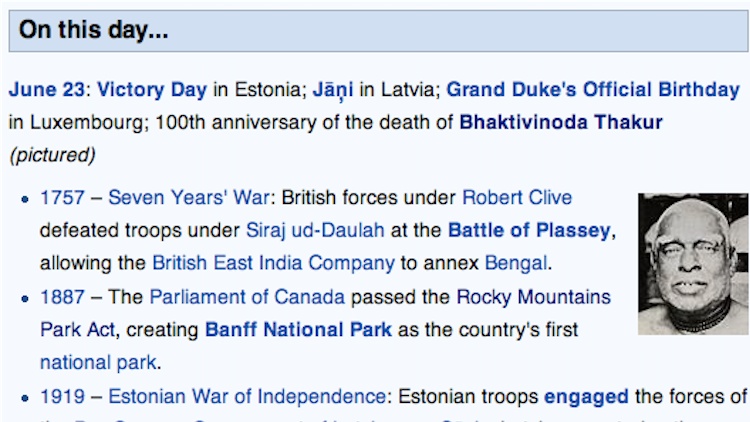Wikipedia’s Main Page Shows Growing Recognition of Gaudiya Vaishnavism
By Madhava Smullen | Aug 01, 2014

Wikipedia. With 30 million articles written by volunteers worldwide, the free Internet encyclopedia receives nearly 500 million unique visitors a month, and is the fifth most popular website in the world. Usually the first link on Google no matter what your search, it has become the knee-jerk source of information for most people.
Because Wikipedia articles must be written using reliable references from the media and academia, Wikipedia can also reflect a certain subject’s popularity trends in the mainstream. Which is why Krishna devotees, and particularly Gaudiya Vaishnavas, have lately been watching the site with interest.
Since 2011, topics and personalities of importance to Gaudiya Vaishnavas and ISKCON devotees have been appearing, with increasing regularity, on Wikipedia’s main page.
“To be featured on the main page, articles have to be based on what the Wikipedia community calls ‘reliable sources,’” says Madan Mohan Das, a member of the ISKCON Communications Global Committee and Sastric Advisory Committee.
“These can be newspapers or other forms of media with established editorial policies, or publications by schools, universities, or scholars,” he continues. “So Gaudiya Vaishnava topics appearing on the main page mean that the media and the scholarly community is taking a closer interest in these topics, and considers us to be a mainstream movement that is here to stay.”

Wikipedia main page on February 8, 2014.
Wikipedia’s main page is divided into five quadrants, which are updated daily: Featured Article, In The News, Did You Know…, On This Day…, and Today’s Featured Picture.
In 2011, when articles about ISKCON and Gaudiya Vaishnava began appearing on it, around five million people were visiting the main page every day.
On January 11th 2011, they were all treated to an interesting nugget in the “Did You Know…” section. “Did you know…” it read, “That Janis Joplin with Big Brother and the Holding Company, The Grateful Dead, and Moby Grape performed at the Mantra-Rock Dance, a charity event for the San Francisco Hare Krishna temple?” referencing one of ISKCON’s most historical events in 1967.
Next, on March 9th, came “Did you know… that a US-born ex-hippie Malati Dasi, despite fierce opposition, in 1998 became the first international female leader of the Hare Krishna movement?”
And on July 16th, the Mantra-Rock Dance returned as the Wikipedia main page’s ‘Featured Article’, the site’s highest honor.
“In Wikipedia parlance, these are the top quality articles, the ones that are immaculate, in terms of style, punctuation, references, flow of prose, and objectivity,” says Madan Mohan. “So they get the most prominent location, the top left spot on the main page.”

Malati Dasi mentioned on Wikipedia main page.
The spot included a snippet from the article and a link to the full piece about The Mantra Rock Dance, a concert event at San Francisco’s Avalon Ballroom in 1976 that promoted the first ISKCON temple on the West Coast, and brought ISKCON founder Srila Prabhupada’s message to the wider attention of the American public.
Meanwhile the Mantra-Rock Dance poster, featuring a psychedelic picture of Srila Prabhupada, the words “Krishna Consciousness Comes West,” and the names of the famous musicians who appeared at the event – such as the Grateful Dead, Big Brother and the Holding Company, and Moby Grape — appeared as the featured photo.
Following the Mantra-Rock Dance article, on December 22nd 2011, the “Did You Know…” section read, “Did you know… that a Russian state prosecutor proposes to put a commented translation of the Bhagavad-gita on the same list of banned materials as Hitler’s Mein Kampf?”
The provocative lead-in linked to an article about how Srila Prabhupada’s translation of Bhagavad-gita was brought to trial in June 2011 in Tomsk, Russia by state prosecutors in an attempt to ban it. The case caused a storm of criticism in Indian, Russian and international media, and was dismissed in December of the same year, a decision lauded by communities in India and Russia.
After some time of silence on Wikipedia’s main page, Gaudiya Vaishnava topics again began appearing with some regularity in 2014. Now, with Wikipedia becoming ever more popular, they were viewed by some ten to fifteen million people in one day.
On February 6th 2014, the main page asked, “Did you know… that Bimala Prasad would be feared as the “lion guru” and respected a “living encyclopedia”?” and featured a photo of the future Bhaktisiddhanta Sarasvati, Srila Prabhupada’s guru, as a young boy.
On February 8th, it read, “Did you know… that Ferdinando Sardella’s doctoral thesis on the “forefather” of the Hare Krishna movement [Bhaktisiddhanta] received the academic award for “outstanding research in religion”?
On June 23rd, the 100th anniversary of the disappearance of Vaishnava saint Bhaktivinode Thakur, Bhaktisiddhanta’s father, was commemorated with a photo of him, in the “On This Day” section.
And on July 7th, “Did You Know?” asked, “Did you know… that although Bhaktivinode Thakur had fourteen children from two marriages and a well-paid job, he was hailed as ‘the seventh Goswami’ (renounced ascetic)?”
All these features on the main page increased the amount of visits to the full articles about these pioneering Vaishnavas, with 20,000 people reading about Bhaktivinode Thakur on the 100th anniversary of his disappearance, and 16,000 reading about Bhaktisiddhanta Sarasvati when he was featured.
What’s more, other articles about Srila Prabhupada, ISKCON, and more that were referenced in the articles about Bhaktivinode and Bhaktisiddhanta also rose in readership.
More recently, a photograph of Yogapith, the birthplace of Gaudiya Vaishnavism founder Sri Chaitanya Mahaprabhu in Mayapur, West Bengal, was made a featured picture on Wikipedia and, according to the site, “is considered one of the finest images.”
This trend of ISKCON and Gaudiya Vaishnava related articles on Wikipedia’s main page is expected to continue during celebrations of Srila Prabhupada’s arrival in the US in 2015, and ISKCON’s 50th anniversary in 2016.
“ISKCON’s public perception has been a long and often winding road – from obscurity through ridicule to respect,” says Anuttama Dasa, ISKCON Communications minister and the current GBC chair. “To me, increasingly frequent mentions of ISKCON by the main global information resource, Wikipedia, are yet another sign of our recognition as a mainstream religious denomination based on profound philosophy and ancient culture. This is encouraging, and I hope that we collectively work hard enough in representing Srila Prabhupada’s legacy to the world to measure up to this perception.”














